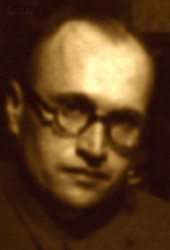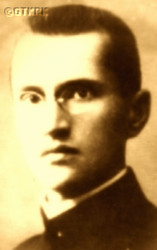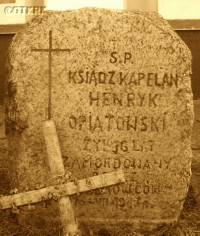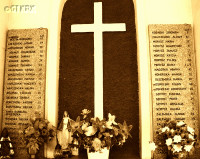Roman Catholic
St Sigismund parish
05-507 Słomczyn
85 Wiślana Str.
Konstancin deanery
Warsaw archdiocese, Poland
full list:
displayClick to display full list

searchClick to search full list by categories
wyświetlKliknij by wyświetlić pełną listę po polsku

szukajKliknij by przeszukać listę wg kategorii po polsku

Martyrology of the clergy — Poland
XX century (1914 – 1989)
personal data
surname
OPIATOWSKI
forename(s)
Henry (pl. Henryk)
function
diocesan priest
creed
Latin (Roman Catholic) Church RCmore on
en.wikipedia.org
[access: 2014.09.21]
diocese / province
Vilnius archdiocesemore on
en.wikipedia.org
[access: 2013.05.19]
Pinsk diocesemore on
en.wikipedia.org
[access: 2013.05.19]
RC Military Ordinariate of Polandmore on
en.wikipedia.org
[access: 2014.12.20]
honorary titles
Honorary Citizenmore on
Honorary Citizen
(28.04.2009, Bielsk Podlaskitoday: Bielsk Podlaski gm., Bielsk Podlaski pov., Podlaskie voiv., Poland
more on
en.wikipedia.org
[access: 2021.09.29])
date and place
of death
15.07.1943

Pilicki foresttoday: Bielsk Podlaski gm., Bielsk Podlaski pov., Podlaskie voiv., Poland
more on
en.wikipedia.org
[access: 2022.01.28]
details of death
Following German invasion of Poland on 01.09.1939 (Russians invaded Poland 17 days later) and start of the World War II chaplain of the 1.
Joseph Piłsudski Legions Infantry Regiment, in captain rank.
The Regiment, mobilized in 08.1939 as part of the 1st Infantry Division of the Legions of the Operational Group „Wyszków”, initially fought with the Germans defending the Narew and Bug rivers' lin. On 10.09.1939 started retreating towards Biała Podlaska. On 11‐12.09.1939 fought for Kałuszyn suffering heavy losses. On 13‐14.09.1939 battled at Stoczek. On 14.09.1939, during the attack on Trzciniec, it basically ceased to exist as an independent unit. The remnants of the Regiment capitulated on 23‐24.09.1939.
Avoided internment.
Returned to home village Domanowo.
There during Russian and next, from 06.1941, German occupation ministered in local parishes.
Chaplain of the Polish resistance Armed Struggle Union ZWZ and Home Army AK (part of Polish Clandestine State).
Gave shelter to the Polish partisans.
After German attack on 22.06.1941 of their erstwhile ally, Russians, and start of German occupation, arrested by the Germans on 15.07.1943 for hiding the Jews that escaped from Brańsk ghetto and for helping Russian escapees from German camps — prob. denounced by somebody close to him.
In Brańsk, where in 1943 became a vicar, in 1938 lived 4,594 people, the majority of whom were Jews (in 1921 c. 58%). The Germans established the Brańsk ghetto in 1941, immediately after the beginning of the German occupation, locking 2,400‐3,000 Jews in it. Liquidated it on 01‐02.11.1942, transporting the Jews to the German extermination camp VL Treblinka, where they were murdered. C. 200 people managed to escape and hide in the surrounding forests and with his parishioners.
Beaten and tortured — Germans apparently told him that „You would be crucified as your Christ”.
Taken to Bielsk Podlaski Gestapo prison on a horse car.
Yet on the same day brought out and murdered in a mass execution — part of German extermination plan of Polish intelligentsia of Białystok region, called «Black July» 1943 — together with Fr Antoni Beszta–Borowski and Fr Louis Olszewski, among others.
cause of death
mass murder
perpetrators
Germans
sites and events
Pilicki forestClick to display the description, «Black July» 1943Click to display the description, VL TreblinkaClick to display the description, Help to the JewsClick to display the description, Ribbentrop‐MolotovClick to display the description, Pius XI's encyclicalsClick to display the description
date and place
of birth
01.06.1907

Domanowotoday: Brańsk gm., Bielsk Podlaski pov., Podlaskie voiv., Poland
more on
en.wikipedia.org
[access: 2022.01.06]
parents
OPIATOWSKI Francis
🞲 ?, ? — 🕆 ?, ?

PARAFIAŃCZUK Leocadia
🞲 ?, ? — 🕆 ?, ?
presbyter (holy orders)
ordination
04.06.1933

Vilniustoday: Vilnius city dist., Vilnius Cou., Lithuania
more on
en.wikipedia.org
[access: 2022.01.06]
St John the Baptist and St John the Evangelist RC churchmore on
en.wikipedia.org
[access: 2017.05.20]
positions held
1943
vicar — Brańsktoday: Brańsk gm., Bielsk Podlaski pov., Podlaskie voiv., Poland
more on
en.wikipedia.org
[access: 2020.12.11] ⋄ Assumption of the Blessed Virgin Mary RC parish ⋄ Brańsktoday: Brańsk gm., Bielsk Podlaski pov., Podlaskie voiv., Poland
more on
en.wikipedia.org
[access: 2020.12.11] RC deanery
1939 – 1943
priest — Domanowotoday: Brańsk gm., Bielsk Podlaski pov., Podlaskie voiv., Poland
more on
en.wikipedia.org
[access: 2022.01.06] ⋄ St Dorothy Virgin and Martyr RC parish ⋄ Brańsktoday: Brańsk gm., Bielsk Podlaski pov., Podlaskie voiv., Poland
more on
en.wikipedia.org
[access: 2020.12.11] RC deanery
1939 – 1943
priest — Brańsktoday: Brańsk gm., Bielsk Podlaski pov., Podlaskie voiv., Poland
more on
en.wikipedia.org
[access: 2020.12.11] ⋄ Assumption of the Blessed Virgin Mary RC parish ⋄ Brańsktoday: Brańsk gm., Bielsk Podlaski pov., Podlaskie voiv., Poland
more on
en.wikipedia.org
[access: 2020.12.11] RC deanery
c. 1938
priest — (Czechoslovakia territory)today: Czekia and Slovakia
more on
en.wikipedia.org
[access: 2023.11.24] — prob.
1937 – 1938
resident — Choroszcztoday: Choroszcz gm., Białystok pov., Podlaskie voiv., Poland
more on
en.wikipedia.org
[access: 2022.01.06] ⋄ St John the Baptist RC parish ⋄ Białystoktoday: Białystok city pov., Podlaskie voiv., Poland
more on
en.wikipedia.org
[access: 2020.12.11] RC deanery
1935 – 1936
vicar — Myorytoday: Myory dist., Vitebsk reg., Belarus
more on
en.wikipedia.org
[access: 2024.03.19] ⋄ Assumption of the Blessed Virgin Mary RC parish ⋄ Myorytoday: Myory dist., Vitebsk reg., Belarus
more on
en.wikipedia.org
[access: 2024.03.19] RC deanery
vicar — Borodenichitoday: Teterki ssov., Braslaw dist., Vitebsk reg., Belarus
more on
be.wikipedia.org
[access: 2022.08.05] ⋄ St Joseph Spouse of the Blessed Virgin Mary RC parish ⋄ Myorytoday: Myory dist., Vitebsk reg., Belarus
more on
en.wikipedia.org
[access: 2024.03.19] RC deanery
1933 – 1935
vicar — Lentvaristoday: Lentvaris eld., Trakai dist., Vilnius Cou., Lithuania
more on
en.wikipedia.org
[access: 2022.01.06] ⋄ Annunciation and Visitation of the Blessed Virgin Mary RC parish ⋄ Trakaitoday: Trakai eld., Trakai dist., Vilnius Cou., Lithuania
more on
en.wikipedia.org
[access: 2022.01.06] RC deanery
1933
vicar — Ladsktoday: Ladsk ssov., Shchuchyn dist., Grodno reg., Belarus
more on
be.wikipedia.org
[access: 2023.01.18] ⋄ St Stanislav the Bishop and Martyr RC parish ⋄ Vasilishkitoday: Vasilishki ssov., Shchuchyn dist., Grodno reg., Belarus
more on
en.wikipedia.org
[access: 2020.11.27] RC deanery
till 1933
student — Vilniustoday: Vilnius city dist., Vilnius Cou., Lithuania
more on
en.wikipedia.org
[access: 2022.01.06] ⋄ philosophy and theology, Theological Seminary
comments
It is not clear how he became the chaplain of the 1st Legions Infantry Regiment.
His name is not included in the list of chaplains of the Polish Army (active and reserve) nominated until 09.1939.
Thus, he could not have been mobilized in 08.1939.
Perhaps he voluntarily joined the regiment during its relocation from the vicinity of Vilnius to the mobilization sites in the forests between the Narew and Bug rivers.
But it is also possible that he joined it during the withdrawal of the Regiment to the south, in constant fighting with the Germans, although the withdrawal line was located about 50 km west of his whereabouts in Domanowo.
others related
in death
BESZTA–BOROWSKIClick to display biography Anthony, BURAKClick to display biography Mark, KLIMCZAKClick to display biography Michael Eugene (Fr Dennis), KOCHANOWSKIClick to display biography Felix, KOZŁOWSKIClick to display biography Joseph, KUŹMICKIClick to display biography Witold, OLSZEWSKIClick to display biography Louis, PĘZAClick to display biography Alexander, PŁOŃSKIClick to display biography Joseph, ROSZAKClick to display biography Edmund, RUTKOWSKIClick to display biography Bronislav, SKOKOWSKIClick to display biography Justin, SZULCClick to display biography Joseph, SZYPIŁŁOClick to display biography Casimir
sites and events
descriptions
Pilicki forest: Mass murder on 15.07.1943 of approx. 50 residents of Bielsk Podlaski, mainly from intelligentsia, including 17 children (the youngest was 2 years old) and 3 Catholic priests. Altogether on 13‐15.07.1943 Germans murdered c. 1,000 people from towns and villages of Białystok region not accidentally, is believed, choosing dates when Polish‐Lithuanian victory over Teutonic Knights in a battle of Grunwald, that was held in 1410, is remembered. (more on: groby.radaopwim.gov.plClick to attempt to display webpage
[access: 2013.01.13], pl.wikipedia.orgClick to attempt to display webpage
[access: 2014.12.20])
«Black July» 1943: On 20.05.1943 East Prussia German Germ. Gauleiter (Eng. regional leader), Erich Koch, nominated Otton Helwig a new German commander of SS und Polizeiführer (Eng. SS and police commander) of Bezirk (Eng. region) Białystok. He immediately initiated a pacification action ostensibly targeted at Polish partisans. The real aim was intimidation of the Poles from Białystok region and extermination of its leading classes. Herbert Zimmermann, security police and SD commanded, deputy commander of Einsatzgruppen SS (Eng. Operational Groups) for Germ. Bezirk (district) Bialystok, issued an order to arrest and execute 19 people, physicians, barristers, city staff and teacher, including their families, in each all county cities of the district. On 10.07.1943 a „Commando Müller” (from the surname of its murderous commander, prob. Hermann Müller), consisting of Belarus support batallion, Lithuanian units dressed in German uniforms, German Gendarmerie and police and German Gestapo members, perpetrated a series of mass murders in various places in Bezirk Białystok (including its Łomża and Grodno regions). In 07.1943 Germans murdered more than 1,000 people (prob. near 2,000). On 15.07.1943 only in all county seats of Bezirk Bialystok at least 9 local Polish intelligentsia families, including women, children and old were selected and murdered. Among the victims were many priests: in executions in Pilice forest, Wiszownik forest, Kosówka forest, Navumavichy, Jeziorka, etc. Germans murdered at least 15 clerics. (more on: www.swzygmunt.knc.plClick to attempt to display webpage
[access: 2019.10.13])
VL Treblinka: SS‐Sonderkommando Treblinka, Germ. Vernichtungslager (Eng. extermination camp) VL, of Polish Jews. Operational from 07.1942 till 11.1943. Largest extermination camp in German‐run General Governorate. Main site of mass genocide of Jewish population from Warsaw ghetto and other ghettoes in German occupied Poland. Among the victims were Jews from Austria, Czechia, Greece, Yugoslavia, Germany and Slovakia, and Romani people. Victims were murdered in stationary gas chambers equipped as public showers. Corpses were burnt and cremated. The number of murdered is estimated at 700,000‐900,000. (more on: en.wikipedia.orgClick to attempt to display webpage
[access: 2020.07.31])
Help to the Jews: During World War II on the Polish occupied territories Germans forbid to give any support to the Jews under penalty of death. Hundreds of Polish priests and religious helped the Jews despite this official sanction. Many of them were caught and murdered.
Ribbentrop‐Molotov: Genocidal Russian‐German alliance pact between Russian leader Joseph Stalin and German leader Adolf Hitler signed on 23.08.1939 in Moscow by respective foreign ministers, Mr. Vyacheslav Molotov for Russia and Joachim von Ribbentrop for Germany. The pact sanctioned and was the direct cause of joint Russian and German invasion of Poland and the outbreak of the World War II in 09.1939. In a political sense, the pact was an attempt to restore the status quo ante before 1914, with one exception, namely the „commercial” exchange of the so‐called „Kingdom of Poland”, which in 1914 was part of the Russian Empire, fore Eastern Galicia (today's western Ukraine), in 1914 belonging to the Austro‐Hungarian Empire. Galicia, including Lviv, was to be taken over by the Russians, the „Kingdom of Poland” — under the name of the General Governorate — Germany. The resultant „war was one of the greatest calamities and dramas of humanity in history, for two atheistic and anti‐Christian ideologies — national and international socialism — rejected God and His fifth Decalogue commandment: Thou shall not kill!” (Abp Stanislav Gądecki, 01.09.2019). The decisions taken — backed up by the betrayal of the formal allies of Poland, France and Germany, which on 12.09.1939, at a joint conference in Abbeville, decided not to provide aid to attacked Poland and not to take military action against Germany (a clear breach of treaty obligations with Poland) — were on 28.09.1939 slightly altered and made more precise when a treaty on „German‐Russian boundaries and friendship” was agreed by the same murderous signatories. One of its findings was establishment of spheres of influence in Central and Eastern Europe and in consequence IV partition of Poland. In one of its secret annexes agreed, that: „the Signatories will not tolerate on its respective territories any Polish propaganda that affects the territory of the other Side. On their respective territories they will suppress all such propaganda and inform each other of the measures taken to accomplish it”. The agreements resulted in a series of meeting between two genocidal organization representing both sides — German Gestapo and Russian NKVD when coordination of efforts to exterminate Polish intelligentsia and Polish leading classes (in Germany called «Intelligenzaktion», in Russia took the form of Katyń massacres) where discussed. Resulted in deaths of hundreds of thousands of Polish intelligentsia, including thousands of priests presented here, and tens of millions of ordinary people,. The results of this Russian‐German pact lasted till 1989 and are still in evidence even today. (more on: en.wikipedia.orgClick to attempt to display webpage
[access: 2015.09.30])
Pius XI's encyclicals: Facing the creation of two totalitarian systems in Europe, which seemed to compete with each other, though there were more similarities than contradictions between them, Pope Pius XI issued in 03.1937 (within 5 days) two encyclicals. In the „Mit brennender Sorge” (Eng. „With Burning Concern”) published on 14.03.1938, condemned the national socialism prevailing in Germany. The Pope wrote: „Whoever, following the old Germanic‐pre‐Christian beliefs, puts various impersonal fate in the place of a personal God, denies the wisdom of God and Providence […], whoever exalts earthly values: race or nation, or state, or state system, representatives of state power or other fundamental values of human society, […] and makes them the highest standard of all values, including religious ones, and idolizes them, this one […] is far from true faith in God and from a worldview corresponding to such faith”. On 19.03.1937, published „Divini Redemptoris” (Eng. „Divine Redeemer”), in which criticized Russian communism, dialectical materialism and the class struggle theory. The Pope wrote: „Communism deprives man of freedom, and therefore the spiritual basis of all life norms. It deprives the human person of all his dignity and any moral support with which he could resist the onslaught of blind passions […] This is the new gospel that Bolshevik and godless communism preaches as a message of salvation and redemption of humanity”… Pius XI demanded that the established human law be subjected to the natural law of God , recommended the implementation of the ideal of a Christian state and society, and called on Catholics to resist. Two years later, National Socialist Germany and Communist Russia came together and started World War II. (more on: www.vatican.vaClick to attempt to display webpage
[access: 2023.05.28], www.vatican.vaClick to attempt to display webpage
[access: 2023.05.28])
sources
personal:
polacyratujacyzydow.plClick to attempt to display webpage
[access: 2016.11.06], miory.blog.onet.plClick to attempt to display webpage
[access: 2013.01.13], gmnr1.pdt.plClick to attempt to display webpage
[access: 2016.11.06], www.polacyizydzi.plClick to attempt to display webpage
[access: 2013.02.15]
bibliographical:
„Vilnius archdiocese clergy martyrology 1939‐1945”, Fr Thaddeus Krahel, Białystok, 2017
„Pinsk Diocese in Poland Clergy and Church Register”, Pinsk diocese bishop, 1933‐1939, diocesan printing house
original images:
www.polacyizydzi.comClick to attempt to display webpage
[access: 2014.09.21], gmnr1.pdt.plClick to attempt to display webpage
[access: 2016.11.06], gmnr1.pdt.plClick to attempt to display webpage
[access: 2016.11.06], www.blogmedia24.plClick to attempt to display webpage
[access: 2016.11.06], groby.radaopwim.gov.plClick to attempt to display webpage
[access: 2014.11.14], www.ciekawepodlasie.plClick to attempt to display webpage
[access: 2020.07.31]
LETTER to CUSTODIAN/ADMINISTRATOR
If you have an Email client on your communicator/computer — such as Mozilla Thunderbird, Windows Mail or Microsoft Outlook, described at WikipediaPatrz:
en.wikipedia.org, among others — try the link below, please:
LETTER to CUSTODIAN/ADMINISTRATORClick and try to call your own Email client
If however you do not run such a client or the above link is not active please send an email to the Custodian/Administrator using your account — in your customary email/correspondence engine — at the following address:

giving the following as the subject:
MARTYROLOGY: OPIATOWSKI Henry
To return to the biography press below:
 Click to return to biography
Click to return to biography













